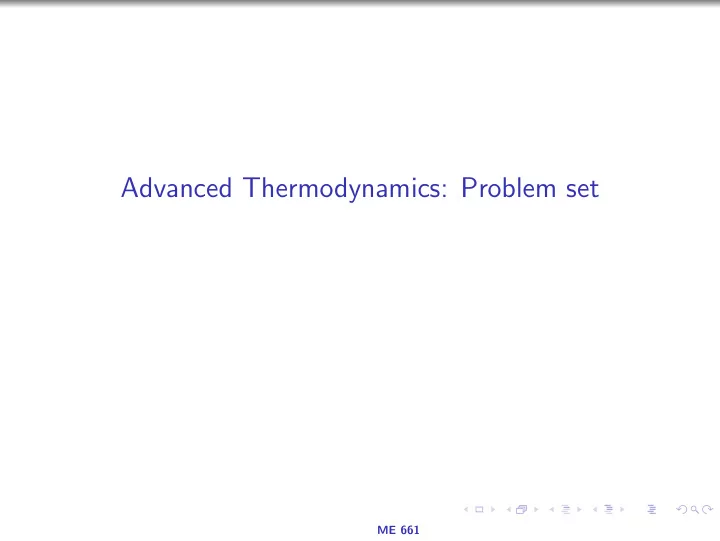

Advanced Thermodynamics: Problem set ME 661
Estimate the total number of air molecules in your classroom. ME 661
Estimate the density of dry air at sea level on a warm summer day. ME 661
A stoppered test tube that has a volume of 10.0 mL has 1.00 mL of water at its bottom. The water has a temperature of 100C and is initially at a pressure of 1.00 atm. The test tube is held over a flame until the water has completely boiled away. Estimate the final pressure inside the test tube. ME 661
Estimate the average pressure on the front wall of a squash court, due to the collisions of the ball with the wall during a game. Use any reasonable numbers for the mass of the ball, its typical speed, and the dimensions of the court. Is the average pressure from the ball significant compared to that from the air? ME 661
The escape speed at the surface of a planet of radius R is v e = √ 2 gR , where g is the acceleration due to gravity at the � surface of the planet. If the rms speed ( v rms = 3 RT / M )of a gas is greater than about 15 to 20 percent of the escape speed of a planet, virtually all of the molecules of that gas will escape the atmosphere of the planet. (a) At what temperature is v rms for O 2 equal to 15 percent of the escape speed for Earth? (b) At what temperature is v rms for H 2 equal to 15 percent of the escape speed for Earth? (c) Compute the temperatures for which the rms speeds of O 2 and H 2 are equal to 15 percent of the escape speed at the surface of the moon, where g is about one-sixth of its value on Earth and R = 1738 km. How does this account for the absence of an atmosphere on the moon? ME 661
To a first approximation, the Sun consists of a gas of equal numbers of protons and electrons. The temperature at the center of the Sun is about 1 × 10 7 K, and the density of the Sun is about 1 × 10 5 kg/m3. Because the temperature is so high, the protons and electrons are separate particles (rather than being joined together to form hydrogen atoms). (a) Estimate the pressure at the center of the Sun. (b) Estimate the rms speeds of the protons and the electrons at the center of the Sun. 1 Mol wt of Proton ≈ 1. Mol wt of electron ≈ = 2000 ME 661
The escape speed for gas molecules in the atmosphere of Mars is 5.0 km/s and the surface temperature of Mars is typically 0C. Calculate the rms speeds for (a) H 2 , (b) O 2 , and (c) CO 2 at this temperature. (d) Are H 2 , O 2 , and CO 2 likely to be found in the atmosphere of Mars? ME 661
The escape speed for gas molecules in the atmosphere of Jupiter is 60 km/s and the surface temperature of Jupiter is typically 150C. Calculate the rms speeds for (a) H 2 , (b) O 2 , and (c) CO 2 at this temperature. (d) Are H 2 , O 2 , and CO 2 likely to be found in the atmosphere of Jupiter? ME 661
Determine the number of ways of placing two balls in three numbered containers for (a) Maxwell– Boltzmann statistics, (b) Fermi–Dirac statistics, and (c) Bose–Einstein statistics. Construct a table that identifies each of the ways for all three cases. ME 661
A thermodynamic assembly consists of five independent particles having access to two energy levels. A particular particle distribution for this system and the associated degeneracies for each energy level are as follows: (1) N 1 = 2, g 1 = 4; (2) N 2 = 3, g 2 = 6. Determine the number of microstates for this macrostate if the particles are (a) bosons and (b) fermions. ME 661
A dilute system at thermodynamic equilibrium consists of 50 independent, indistinguishable particles. Each particle has three energy levels of energy 0, ǫ , and 2 ǫ , with degeneracies of 300, 600, and 1200, respectively. The system is at a constant temperature T = ǫ k , where k is Boltzmann?s constant. (a) Calculate the molecular partition function for this thermodynamic system. (b) How many particles are in each energy level? (c) Using Boltzmann’s relation, determine the entropy of this system. (d) Determine the internal energy for this thermodynamic system. (e) Calculate the entropy directly from the partition function. ME 661
Recommend
More recommend